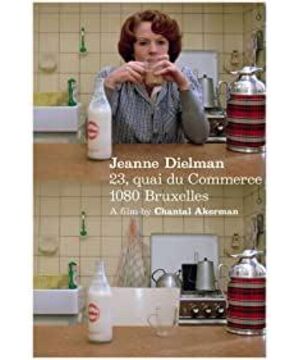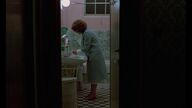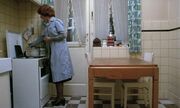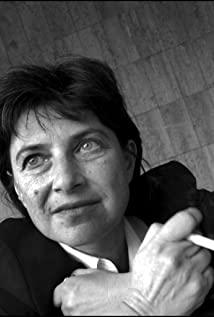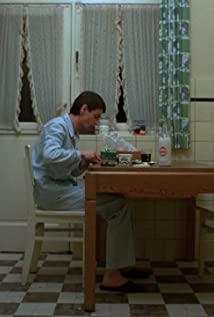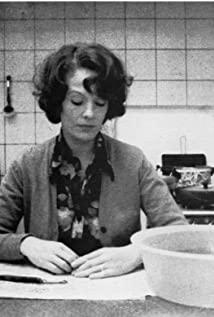What kind of movie is Jeanne Dillman? It is a three-and-a-half-hour film by Ackerman in 1975, another well-known "feminist" film, and a very revolutionary film in both form and content. In short, Ackerman, a Belgian female director with very few films, made this film in her early twenties, which is enough for countless film critics and film historians to establish a biography for her. Its uniqueness and avant-garde have far exceeded our imagination. I believe that there will be no such wonderful viewing experience in the future!
The content of the film can be summed up in one sentence: the daily life of a middle-aged widow for three days (the film is actually from the afternoon of the first day to the afternoon of the third day, it is only a little more than two days after careful calculation), the filming method of the film is also Very "simple" - fixed long shots (the camera selection in the film is very strict, for example, the kitchen has two front and side camera positions, and there are only a dozen or so cameras in the whole film), and the film scene is also very " Monotonous" - over 90% filmed in Jeanne Dillman's apartment. Is there anything special about the daily life of this middle-aged widow? Worth "wasting" our three and a half hours? In fact, 90% of Dillman's life is ordinary and ordinary: getting up, cooking for his son, shopping for vegetables, knitting, washing dishes, making the bed... Then the movie took more than three hours to show Dill Mann gets up, washes, cooks, eats, shines shoes...and it's all "drab, tedious" long takes: no camera movement, no scene switching. Compared to other movies, it's simply vodka and plain water. If there's anything special about that 10%, it's that Dillman has a regular client at home every afternoon. The film is "cherishing ink like gold" in expressing this "special work", and the film would rather spend ten minutes "completely documenting" Dillman washes a few dishes and does it again the next day, and doesn't want to give even one more shot here. The guest rang the doorbell, Dillman got up to open the door, helped the guest with a hat and scarf, and then the two walked through the aisle to the bedroom. The corridor light went out and then turned on again after a while. Dillman and the guest walked out of the bedroom, Dillman handed the guest the hat , scarf, the guests give Dillman money, and finally open the door and leave. In less than a minute before and after, we walk into Dillman's life, but her life is still mysterious and puzzling, and the audience thinks they have fully understood this woman, but she is far from being as simple as we think! The scene at the end of the film suddenly cuts into the bedroom, which shocks the audience enough to offset the three hours of "dullness". It turns out that the director wanted to create suspense, not to obliterate Dillman's identity as a "prostitute". On the contrary, the film also reminds the audience of Dillman's "prostitute" status from time to time. Dillman put money from clients in ceramic jars on the living room table. In many parts of the film, we can see the juxtaposition of the ceramic jar with Dillman: when Dillman and his son are eating, when Dillman knits a sweater, when Dillman withdraws money... It can be said that this ceramic jar is a The object that appears most frequently in the film, and compared to other frequently-appearing objects such as sofas, pots, coffee pots, cups, etc., this ceramic jar has obvious symbolic meaning. If the "prostitute" status is "special", then the "mother" status should be "ordinary", but the movie turns this "ordinary" into "special". Every aspect of Dillman’s life revolves around his son, getting up in the morning to make breakfast for his son, brushing his son’s shoes, going to the street to repair his son’s shoes, looking everywhere for buttons of the same size that his son’s clothes were missing, and buying vegetables for his son. Making the bed and washing the dishes, the film keeps depicting Dillman's actions. Ackerman is not only meticulous in the video, but most of the only dialogues in the whole film are dialogues with his son, and the other small parts of the dialogues with the shoe repairer, selling wool, and buttons are actually based on his son. of. The son recites Baudelaire's "The Enemy" for Dillman, and a memoir with a strong "Oedipus" complex, which is the hidden information set by the director, these hidden information (what happened in the bedroom and Di Mann and his son's night out) is the director's "hide and seek" with the audience in space, and Dillman's image will always remain in the audience's mind, she will always be a mystery, just like the one who suddenly killed the client in the end Behavior, real or fictional? Accidental or inevitable? Every aspect of Dillman’s life revolves around his son, getting up in the morning to make breakfast for his son, brushing his son’s shoes, going to the street to repair his son’s shoes, looking everywhere for buttons of the same size that his son’s clothes were missing, and buying vegetables for his son. Making the bed and washing the dishes, the film keeps depicting Dillman's actions. Ackerman is not only meticulous in the video, but most of the only dialogues in the whole film are dialogues with his son, and the other small parts of the dialogues with the shoe repairer, selling wool, and buttons are actually based on his son. of. The son recites Baudelaire's "The Enemy" for Dillman, and a memoir with a strong "Oedipus" complex, which is the hidden information set by the director, these hidden information (what happened in the bedroom and Di Mann and his son's night out) is the director's "hide and seek" with the audience in space, and Dillman's image will always remain in the audience's mind, she will always be a mystery, just like the one who suddenly killed the client in the end Behavior, real or fictional? Accidental or inevitable? Every aspect of Dillman’s life revolves around his son, getting up in the morning to make breakfast for his son, brushing his son’s shoes, going to the street to repair his son’s shoes, looking everywhere for buttons of the same size that his son’s clothes were missing, and buying vegetables for his son. Making the bed and washing the dishes, the film keeps depicting Dillman's actions. Ackerman is not only meticulous in the video, but most of the only dialogues in the whole film are dialogues with his son, and the other small parts of the dialogues with the shoe repairer, selling wool, and buttons are actually based on his son. of. The son recites Baudelaire's "The Enemy" for Dillman, and a memoir with a strong "Oedipus" complex, which is the hidden information set by the director, these hidden information (what happened in the bedroom and Di Mann and his son's night out) is the director's "hide and seek" with the audience in space, and Dillman's image will always remain in the audience's mind, she will always be a mystery, just like the one who suddenly killed the client in the end Behavior, real or fictional? Accidental or inevitable?
Dillman's multiple identities: mother, housewife, and prostitute are pushed to a central position in the film, which is the biggest feature of "feminist" films. Feminist Annette Kong pointed out that in films, women are often socially structured as "others" or "outsiders" in a male-dominated world, and women cannot tell their own stories because images are controlled by men and women are often viewed as As a sexual object, only its beauty and sexual attractiveness are valuable. Ackerman's film can be seen as a challenge to the hegemony of traditional male cinema. Women are not mentioned as the center of the story. Those male figures, including Dillman's son, are portrayed as an extension of the heroine's life. In addition, the deceased husband is completely objectified through the photo on the bedroom dresser. In a shot at the end of the film, Dillman is facing the dressing table, the frame is in the lower left corner, Dillman's face is in the mirror and the client is on the bed behind him. In this shot, Dillman is the only "dual existence" with a subject (the actor himself) and a mirror image, while both the client and the deceased husband are "objectified" or "mirrorized". Three-dimensional to plane, a completely "feminist" perspective. "Identity-playing" is a value orientation that should be strongly criticized in "feminist" films. Just like Beauvoir's famous saying, "Women are not born, they are made." Society has added the identity of "woman" to women, so you must play the role of "woman" well. Dillman's "dual identity" is a pointed irony. The two extreme identities of "mother" and "prostitute" imposed by this society on women are opposed to each other. She wants to play both a good mother and a sex worker. We can see plot settings like this in many movies. In Pasolini's "Mama Roma", the mother of Rome sold her body in order to let her son live a life of the upper class. This masterpiece of Pasolini's "new realism" period cannot be regarded as "feminism" An important reason for the film is that it criticizes class issues rather than feminist issues. Also in Elijah Kazan's "East of Eden", the absence of the "mother" and the presence of the "prostitute" reflect the pain and confusion of the son's growth. When it comes to Ackerman, the female image of Jeanne Dillman, who shoulders the dual roles of "mother and prostitute", is truly regarded as a "centralized" rather than "marginalized" subject, with society and male roles as foils. Jeanne Dillman's mystery also broke the single and stereotyped writing mode of female images in previous films. Killing the client in the end is a kind of destruction of "identity play". This destruction is violent and extreme. And the defiance we see in Jacques Rivette's masterpiece "The Voyage of Selena and Julie" is light-hearted, playful . Selina and Julie's several identity swaps (such as Julie's work in Selina's magic show) are very interesting, and what's more, Rivett also makes up a "magic world" where the two heroines The shuttle back and forth between the "real world" and the "ideological world" also makes this film contain other deep thinking in addition to the performance of "feminism". "The Voyage of Selena and Jolie" as a "feminist film" is too narrow, but "Jeanne Dillman" tells the audience from the first shot that this is a "feminist film" through and through. ". "Mothers and prostitutes" is a kind of "Anna Karelina" or "Madame Bovary" female destiny. Can such a dogma really be solved like Dillman with a pair of scissors? In the last scene of the movie, Dillman is sitting in a dark living room, the mottled blue neon outside fills the room through the shutters (suddenly remembered that the protagonist's room in Fassbender's "Berlin Alexanderplatz" is also covered with neon. shrouded in rainbows, but red) There was a five-minute silence in which Dillman was thinking, and Ackerman was thinking.
Jeanne Dillman's experiment in cinematic time and space is bold and memorable. What traditional movies want to do is stretch their lengths desperately, and the time span in a movie is usually huge. The most amazing is the montage of bones turning into spaceships in Kubrick's "2001: A Space Odyssey". This is one of the big advantages that the film has over the drama, the change of the drama time is often achieved through the transition between the scenes, because it is "live". The dramatic style of "Jeanne Dillman" is very obvious, such as the change of time by inserting subtitles, and the rest of the time is Dillman's repetitive, monotonous life arranged according to the order of the time axis. Time has been placed by the director in a position where the audience must be asked to experience and feel (we usually watch commercial movies without paying attention to whether this happened in the morning, at noon or at night? This incident is the same as the previous one. Exactly how long between events? These questions) The film magnifies time, and shortens time (compared to the mental time audiences usually spend watching a movie) You might ask, why does it take so long to make a cup of coffee time? But it may take longer in real life, because traditional movies run a lot faster than reality. Ackerman's experiments certainly expand the way the film is represented. When it comes to "real time movies", one cannot fail to mention Agnès Varda's "Cleo from Five to Seven", which is also a film directed by a female director with a female protagonist. It tells the story of what happened two hours before and after singer Cleo went to the hospital to get the results of a medical examination (she suspected she had a terminal illness). "Jane Dillman" goes further than "Cleo from Five to Seven" in that Cleo's two hours are new and unfamiliar to the audience; Dillman's three days Much of it is repetitive and familiar. Repetition and familiarity do not mean rigid and boring. Dillman's life is full of unexpected events, and while most of them are extremely mundane (such as the shoe brush accidentally falling off while brushing on the third day), they get closer to the essence of life. In the spatial experiment, we can see that because the camera is fixed, sometimes Dillman will walk out of the frame. The traditional method is to let the camera follow the protagonist, but the camera does not move the protagonist to walk in and out. The film breaks through the picture. The limitation of the frame, this is not just as simple as "recording", it is more like a challenge to traditional film theory.
One long shot collages the three-day life of an ordinary middle-aged widow, a film that wanders between the simple and the complex, the real and the unreal, a woman struggling in the role reversal of "mother and prostitute", Together they have created one of the most bizarre and unique myths in the history of world cinema.
View more about Jeanne Dielman, 23, quai du commerce, 1080 Bruxelles reviews


